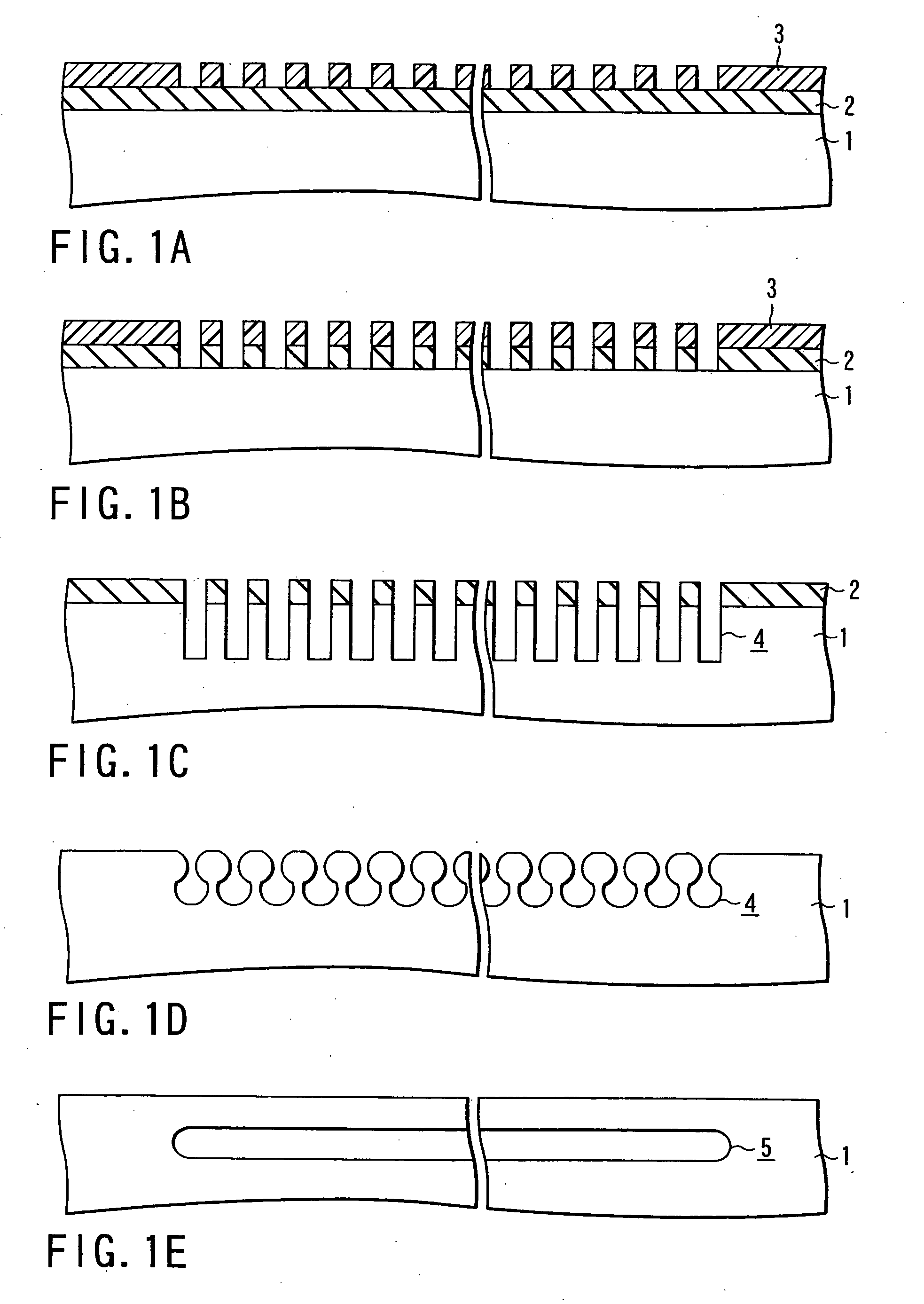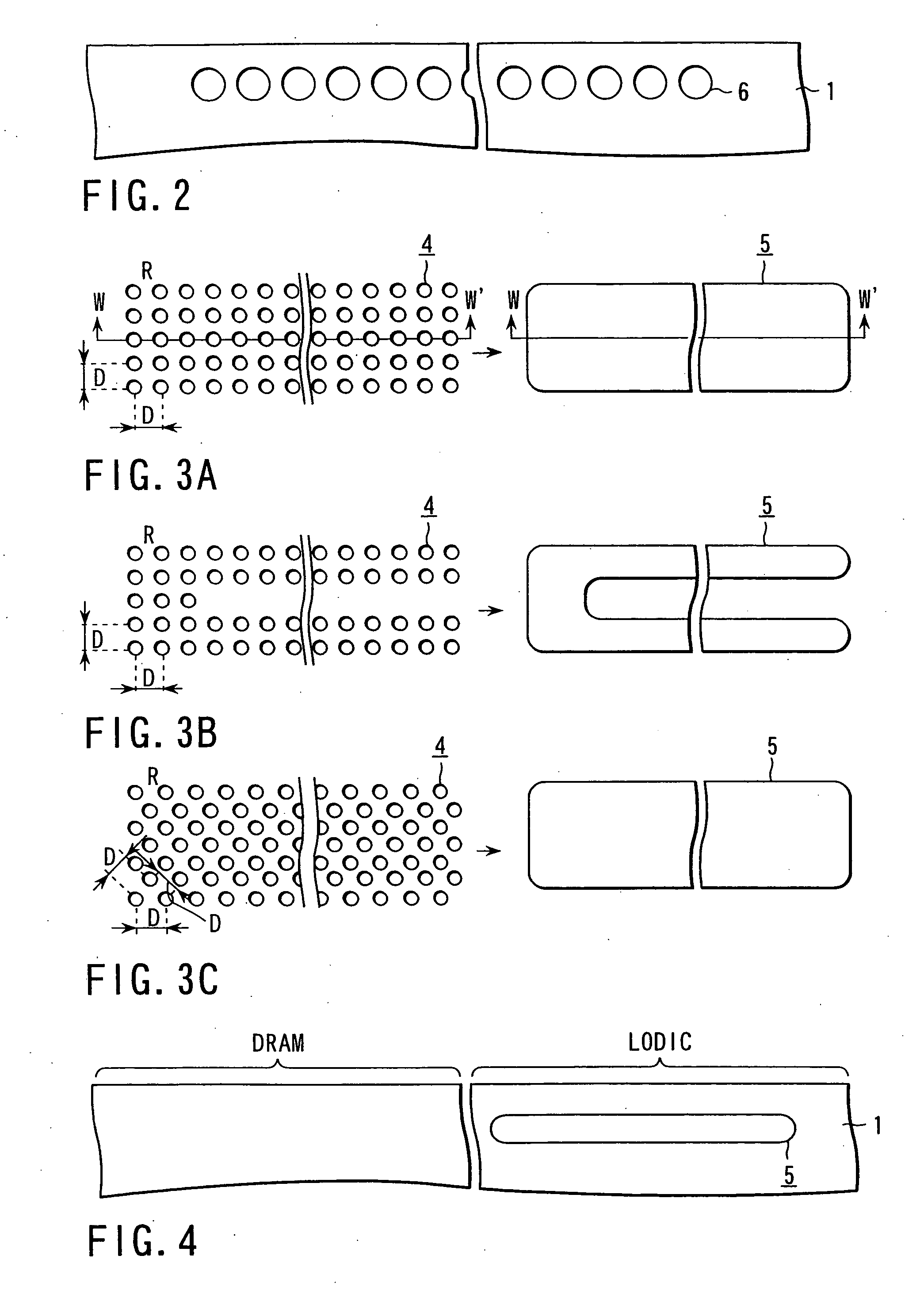Semiconductor substrate and its fabrication method
a technology of semiconductors and substrates, applied in the direction of optical elements, instruments, optical waveguide light guides, etc., can solve the problems of large cost of forming methods, inability to obtain sufficient reliability, and inability to meet the requirements of household electronic devices such as drams, so as to achieve the effect of not raising costs or deteriorating reliability
- Summary
- Abstract
- Description
- Claims
- Application Information
AI Technical Summary
Benefits of technology
Problems solved by technology
Method used
Image
Examples
first embodiment
[0072]FIGS. 1A to 1E are sectional views showing a method for fabricating a silicon substrate having a flat empty space (ESS: Empty Space in Silicon) of the first embodiment of the present invention, that is, an SON (Silicon On Nothing) substrate referred to as an ultimate SOI substrate.
[0073] First, as shown in FIG. 1A, a mask material 2 is formed on a single-crystal silicon substrate 1 and a photoresist pattern 3 is formed on the mask-material 2. The mask material 2 will be described later.
[0074] Then, as shown in FIG. 1B, the mask material 2 is patterned through anisotropic etching such as RIE by using the photoresist pattern 3 as a mask to transfer the pattern of the photoresist pattern 3 to the mask material 2.
[0075] Then, as shown in FIG. 1C, the photoresist pattern 3 is carbonized and separated and then, the silicon substrate is patterned through anisotropic etching such as RIE by using the mask material 2 as a mask to two-dimensionally arrange a plurality of trenches 4 on...
second embodiment
[0103]FIGS. 5A to 5L are sectional views showing a method for fabricating a MOS transistor of the second embodiment of the present invention. In the following drawings, a symbol same as that in a previous drawing shows the same or a corresponding portion and its detailed description is omitted.
[0104] For this embodiment, a case is described in which a flat empty space is formed in a silicon substrate to fabricate a MOS transistor on the flat empty space.
[0105] First, a flat empty space 5 is formed in a silicon substrate 1 as shown in FIG. 5A in accordance with the same method as the case of the first embodiment shown in FIGS. 1A to 1E.
[0106] Then, as shown in FIG. 5B, a silicon oxide film 7, a silicon nitride film 8, and a photoresist pattern 9 are formed in order on the silicon substrate 1.
[0107] In this case, the photoresist pattern 9 is laid out so that at lest a part of the opening of the pattern 9 is brought onto an empty space forming region. FIG. 5B shows a case in which ...
third embodiment
[0127]FIGS. 6A to 6D are sectional views showing a method for fabricating a MOST transistor of the third embodiment of the present invention. For the second embodiment, a method for filling a flat empty space with a silicon oxide film is described. For the third embodiment, however, a method for leaving a flat empty space without filling the empty space with a silicon oxide film is described.
[0128] First, as shown in FIG. 6A, a flat empty space 5 is formed in a silicon substrate 1 in accordance with the method used for the first embodiment shown in FIGS. 1A to 1E.
[0129] Then, as shown in FIG. 6B, a silicon thermal oxide film 24 is formed in the flat empty space 5 and on the surface of the silicon substrate through thermal oxidation. The above thermal oxidation is performed, for example, in a mixed gas of oxygen and HCl at 900° C. A silicon thermal oxide film 22 serves as a stopper under RIE as shown in FIG. 5G in subsequent steps.
[0130] Then, as shown in FIG. 6C, a silicon nitrid...
PUM
 Login to View More
Login to View More Abstract
Description
Claims
Application Information
 Login to View More
Login to View More - R&D
- Intellectual Property
- Life Sciences
- Materials
- Tech Scout
- Unparalleled Data Quality
- Higher Quality Content
- 60% Fewer Hallucinations
Browse by: Latest US Patents, China's latest patents, Technical Efficacy Thesaurus, Application Domain, Technology Topic, Popular Technical Reports.
© 2025 PatSnap. All rights reserved.Legal|Privacy policy|Modern Slavery Act Transparency Statement|Sitemap|About US| Contact US: help@patsnap.com



